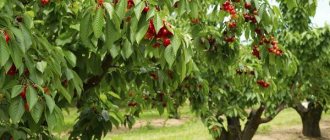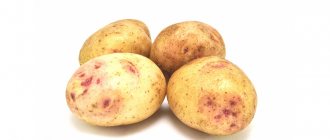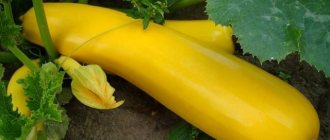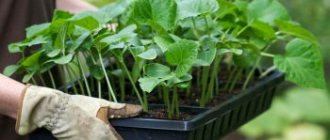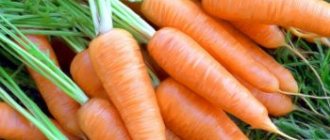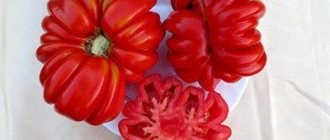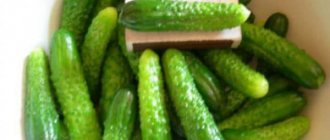Description of the zucchini variety Tsukesha
Tsukesha zucchini grows as a compact bush
Tsukesha is an early ripening variety of zucchini. Already 41-50 days after germination, you can try the first harvest. It is grown in open and closed ground. Grows as a compact bush. Climbing is minimal. The leaves are not prickly, which will be a big plus for young housewives.
The fruits are cylindrical in shape, weigh up to 900 g. The average length is 35-40 cm, diameter is 12 cm. The peel is thin, smooth, dark green with light green specks. The pulp is tender, slightly crispy, white.
Fruit collection
Experts call several stages of maturity of zucchini fruits “tsukesha”. For fresh consumption, it must be collected during milk maturity, when the weight has reached half a kilogram. The next stage is technical maturity. It occurs when the fruit is ripe, but its seeds have not yet fully ripened. In this case, “tsukesha” zucchini is suitable for culinary processing and further storage.
Many domestic gardeners have long abandoned the cultivation of climbing varieties of this vegetable crop in favor of more compact bush varieties. Among the latter, the leading position is occupied by the “tsukesha” zucchini. Reviews about this variety are mostly very good.
Summer residents consider this bush squash, quite common in our gardens, to be a species that combines several indicators: high seed germination, excellent yield and taste of the fruit. The skin of the young harvest of this variety has a pronounced beautiful green color, it is thin and incredibly tender.
Judging by the reviews, when grown in open ground on personal plots in the Moscow region and regions with the same climatic indicators, “tsukesha” squash produces fruits that are equal in size and attractive in appearance. Our summer residents use them everywhere to prepare many main courses and salads, and for canning for the winter season.
Read also: Preparing onions for planting on the head
Characteristics of Zukesh zucchini
Also check out these articles
- Gooseberry variety Ural emerald
- The best raspberry varieties for central Russia
- Processing strawberries in autumn
- What to feed chickens
Tsukesha zucchini can be stored for a long time without loss of taste
The characteristics of the variety speak mostly in its favor. Gardeners note that the Tsukesha variety of zucchini has virtually no drawbacks.
- Productivity in open ground is up to 8 kg per square. In greenhouses it increases to 12 kg.
- Fruiting is friendly and long-lasting.
- Tsukesha zucchini can be stored for a long time without losing its taste. The appearance also does not deteriorate if they are stored correctly.
- Transportation over long and short distances is possible without problems. This variety calmly reacts to minor mechanical damage and does not immediately begin to rot, so it is profitable for sale.
- There is immunity to almost all major diseases inherent in zucchini.
The main problems during cultivation include painstaking care during fruiting. Zucchini needs to be picked on time and the soil should not be allowed to dry out.
Advantages of the variety
Tsukesha has a very good yield and ripens early. From one square meter of plot you can collect approximately 12 kilograms of zucchini. And then such zucchini can be stored for a long time if you follow the conditions for their harvesting. Tsukesha is not afraid of many diseases that are popular for zucchini - he is very resistant to them.
Plus, this zucchini is delicious. It is used to prepare a wide variety of culinary masterpieces. Moreover, it is beneficial to eat it raw.
Note! Zukesh zucchini is very unpretentious. They can be planted in different climates. This garden crop can be grown in a greenhouse or without it. 45 days after planting, you will be able to reap a rich harvest.
Planting zucchini Tsukesha
The easiest way to grow Tsukesha zucchini is by seed method.
To plant the Tsukesha variety of zucchini, fertile, light soil is selected. Groundwater must be low, otherwise rot will appear. Root vegetables, tomatoes, onions, and legumes will be good predecessors. The easiest way to grow Zukesh zucchini is by seed method. Seedlings are done very rarely, and there is no use, because the plant grows quickly and produces a good harvest. In cool regions, the variety is grown in greenhouses.
Important!
Zukesha variety squash does not tolerate acidic soil and produces very low yields.
To obtain early shoots before sowing, the seeds are soaked for a day in liquid fertilizer. This can be an infusion of ash or a solution from the growth stimulator "Energen", "Immunocytophyte" or the like. After this, the seeds are wrapped in a wet paper napkin for 2 days, ventilating and wetting from time to time. They are kept at a temperature of +22 degrees.
Sowing of seeds in a permanent place is carried out around the end of May and until the beginning of June - after the return frosts have passed. If you sow in a greenhouse, you can do it from April. Seeds are always sown in holes of 2-3 pieces, because germination is not always satisfactory. Sowing depth is up to 5 cm. The average distance between holes is 60 cm. They are usually planted in a checkerboard pattern to save space. After the shoots appear, all frail shoots are removed. There should be 1 sprout left in each hole.
Site selection and preparation
This vegetable can be traditionally grown along the fence on the south side or where there is space free from other crops. The main thing is that it is sunny and without stagnant water (preferably located on a hill). It is equally important to consider crop rotation. You cannot plant Tsukesha after other representatives of the Pumpkin family and late cabbage. Its best predecessors are:
- legumes;
- onion;
- garlic;
- potato;
- early cabbage.
As for the neighborhood, in the best case, it is worth placing corn on the north side of the zucchini, and beans along them and between the rows, since they accumulate the nitrogen necessary for the bush plant in the top layer of soil.
After choosing the optimal site, you can begin preparing light soil. It is advisable to do this in advance - in the fall of the previous season. The soil needs to be dug to a depth of 35-50 cm, adding the following fertilizers (per 1 sq. m):
- 5 kg of humus;
- 20 g of potassium sulfate;
- 30 g superphosphate.
In May or at the end of April, 1-1.5 weeks before planting the zucchini, the area should be well loosened and fertilizing containing nitrogen should be added at the rate of 10-15 g per 1 square meter. m.
In regions with a temperate climate, the “warm bed” technology is also used. To prepare it you need to do the following:
- Seal up fallen leaves, wood shavings, sawdust, small twigs and other plant debris to a depth of 50-60 cm. In the end you need to get a single layer of 10 cm.
- Cover the resulting layer with soil or humus mixed with potassium and phosphorus fertilizers.
- Water the entire bed with a fertilizer solution containing nitrogen (20-25 g per 10 l), cover with plastic wrap and leave until spring.
In such a bed, the soil will warm up much faster, so the harvest can be harvested 1.5-2 weeks earlier. However, this technology has a significant drawback - the bushes in the garden often “fatten” to the detriment of fruiting, and in cloudy summer conditions the fruits turn out to be somewhat bland and flabby.
Tsukesha can be grown in dug up and turfed areas, right among the grass. While the seedlings are gaining strength, weeds should not be allowed to choke them. However, zucchini will quickly develop powerful bushes, grow large leaves and be able to independently fight competitors.
Planting care
We recommend reading our other articles
- When to plant cabbage seedlings in 2021
- Nipple drinkers for rabbits
- Periwinkle Flower
- Bagira currant variety
Fertilizers for zucchini Tsukesha
A large harvest of zucchini is possible only with proper care, this also applies to zucchini varieties Tsukesha.
- Watering is carried out as the soil dries. Usually this is once every 5-7 days. If the climate is humid, then you can reduce watering, and if it is dry, increase it more often.
Important!
Do not allow the soil to dry out during flowering or fruiting of zucchini!
- Loosening the soil is carried out the next day after evening watering, or in the evening after morning watering.
- Weeds are collected as they appear. If it is difficult to pull out small weeds, you can wait a little until they grow up, then it will be clearer and easier. And yet you cannot delay this procedure!
- Feeding is carried out as needed. In general, zucchini is one of the few crops that you don’t need to feed at all. They grow quickly and produce good yields without heavy fertilizing. The main thing is to plant them in fertile soil. If the crop grows slowly, you can feed it with minerals (“Nitrophoska”, “Effecton”, “Bud”) or add an infusion of ash and herbs.
- When diseases appear, it is worth spraying the bushes with Topsin-M, Topaz or Isofen. If pests begin to settle on the crop, treatment is also carried out, but with other drugs: “Keltan”, “Iskra”, “Karbofos”, “Triphos”. You can also use folk recipes (salt, garlic solution, ash).
Pre-sowing seed preparation
Regardless of the method of growing zucchini, the seeds must be treated 7-8 days before sowing in order to disinfect and increase their germination. To do this you need to perform a number of actions:
- Soak the seeds for 12-16 hours in a solution of crimson potassium permanganate, an infusion of wood ash or a root formation stimulator. Effective drugs include Epin, Emistim-M and Heteroauxin, and folk remedies include aloe juice, succinic acid, and honey solution. Simultaneously with soaking, carry out culling. Empty seeds will need to be thrown away immediately, since they definitely will not sprout.
- Wrap the seeds in a damp cloth (towel, gauze) and put them in a warm place (+22°) for about 2-5 days so that they germinate. The fabric can be laid out on a saucer and placed on a radiator or other heating device. As it dries, it must be moistened with soft water - melt, rain, spring or settled water.
Ordinary tap water contains chlorine, which is difficult for Zukesh squash to tolerate. In this regard, plantings also cannot be fed with fertilizers containing potassium chloride.
- Before planting, harden the seeds - keep them in the lower compartment of the refrigerator for a day. Thanks to this manipulation, the plant will be more resistant to temperature changes and prolonged cold spells, which is especially important for the northern regions and Siberia.
Harvest and storage
What can be prepared from the Tsukesha zucchini harvest?
Zucchini variety Tsukesha produces a harvest from late June to August. You can start collecting Tsukesha zucchini from the moment they reach normal size - about 35 cm or even earlier. They need to be picked as they ripen to stimulate the development of new fruits. Small zucchini are very tasty, have thin skin and are soft, so they are suitable for any dish. They are often even canned whole.
Important!
If you don’t pick the Tsukesha zucchini in time (while it’s still small), they will overgrow, the skin will become rough and may begin to crack.
After harvesting, the harvest is placed in a refrigerator, cold room or, in extreme cases, in a cellar. Zucchini of this variety can be stored for up to a month, but only if they are not washed after harvesting. The variety has excellent taste characteristics. It is used to prepare a wide variety of dishes, from fresh salads to canned food. Baked zucchini makes very tasty. Often, Zukesh zucchini is also used in the preparation of various infusions and healthy masks for the skin.
Features of cultivation
Seeds are planted in lighted, well-warmed, light soils. Planting dates depend on the climate, but usually occur at the end of April or May. If the weather is cold for a long time, it is better to postpone this procedure to June, since plants need warmth for seed germination and further development.
Quite often, experienced gardeners practice cultivating zucchini as a second crop, planting them in July after the garlic harvest.
Zucchini needs fertile soil. Before planting, organic fertilizers are added to the soil: compost, humus and peat. They contain nitrogen and phosphorus. Be sure to also add wood ash to the soil - the most accessible source of organic potassium. After this, the soil is dug up, watered, and covered with film to retain heat and moisture.
The best predecessors for zucchini are legumes, potatoes, cabbage and onions.
Before planting, the seeds can be soaked in a growth stimulant such as Epin or Zircon, and then wrapped in a damp cloth until they hatch. Pre-soaking the seeds allows you to discard seeds that have lost their germination.
Before planting, the holes are marked, watered, and the seeds are planted. The planting depth is usually 4–6 cm. Usually two seeds are planted, and after they germinate, the weaker sprout is pinched. The most common planting scheme for zucchini is 70x70 cm. When growing zucchini for your own needs, 3-4 bushes are enough, since the resulting harvest is enough for both cooking and food preparations.
For the seedling method of growing zucchini:
- Seeds are sown at the end of March or the first half of April in cups with nutritious soil consisting of an equal amount of peat and humus. The soil mixture is watered with a solution of Fitosporin.
- Plant the seeds into the soil to a depth of 2–3 cm and sprinkle soil on top.
- Seedlings are grown at a temperature of 20 oC.
- Water the pots regularly, avoiding drying out the soil ball or waterlogging it.
- At the stage of 3–4 true leaves, the seedlings are ready.
Plants are planted in the ground early in the morning or on a cloudy day.
Before planting, I try not to water the seedlings, so they are less injured. And so that the lump does not crumble, I plant the seeds in large peat cups, which I embed in the ground. When cultivating zucchini in industrial quantities, this method is expensive, but when you plant only two or three bushes, you don’t have to save money.
After planting, water generously with warm water, trying to apply it strictly at the root so that moisture does not fall on the leaves of the plant. You water the zucchini in the same way later, when they have already grown.
To obtain an early harvest of zucchini, when growing under a film, a warm bed is often built. In this case, the soil warms up due to the processes of decomposition of organic compounds, and the plantings are protected from weather changes by a film cover.
Arranging a warm bed should begin in the fall, and in the spring, when it’s time to plant zucchini, a luxurious bed will be ready. They dig a trench 50–60 cm deep and 70–80 cm wide. Layers of branches, plant debris, manure, leaves and mown grass, and soil are laid alternately from bottom to top. The resulting bed is watered abundantly, covered with a thick film and left until spring.
Arranging a warm bed is not very troublesome, but significantly speeds up the harvest
Caring for plantings comes down to loosening row spacing and removing weeds when the bush is still young. As the zucchini grows, there are practically no weeds left.
Watering is carried out regularly. It is especially important to provide the bushes with moisture during the flowering period and immediately after harvesting the fruits. When watering, it is better to supply water abundantly, trying to saturate the deep layers of the soil. The root system of zucchini is quite powerful, so short, frequent watering is of little use.
When growing zucchini, you often encounter aphids. These parasites multiply quickly and inhibit the development of the bush. I never enjoyed using toxic products, but with the birth of my granddaughter, chemicals became strictly taboo. The current method of fighting aphids is simple and effective: I pour 4 tablespoons of mustard powder into a liter jar and fill it with warm water. I stir well and leave in a warm, dark room for two days. After this, I decant the solution and bring the volume to 10 liters. The resulting product should be poured generously onto all affected bushes: zucchini, cucumbers, squash and pumpkin.
Elegant and neat bushes of Tsukesha zucchini attract the eye during flowering and fill the heart with jubilation when fruiting.
Reviews of Zukesha zucchini
Below are reviews from gardeners who have already tried growing Zukesh zucchini.
- Victor Dontsov : “Through trial and error, I discovered the Tsukesha variety. These zucchini, in my opinion, are the best for storage and overall taste. Very tender, suitable for different dishes. We always close part of the harvest in jars; for this we take only the smallest zucchini. We use the rest for salads and frying.
- Maria Ivanova : “The Tsukesha variety of zucchini is the envy of the neighbors, but I noticed that you need to buy them only in trusted places, otherwise you can end up with a fake. One time, they didn’t grow like bushes, but trudged all over the garden.”
- Nikolai Vashchenko : “My family loves not only Tsukesh fruits, but also flowers. We fry them in batter - very tasty. We seal a little in jars, in circles, for the winter. In general, the variety is good, easy to grow, and grows quickly even without fertilizers.”
Plant diseases
Zucchini gets sick for various reasons. We will list the main ones in the article:
- Plants generally suffer from waterlogged soil. And if you water them with cold water, this can worsen the situation. In addition, Zucchini are very responsive to sudden changes in weather.
- Zucchini also often suffer from pests - caterpillars and aphids. However, if you weed your plants regularly, pests are unlikely to attack them. However, if you notice that insects have damaged the leaves, then these leaves should be removed without delay.
- Folk remedies such as a decoction of hot pepper, wood ash and tooth powder will help you cope with annoying insects.
- Zucchini are often also subject to bacteriosis. A sign of this disease is that the ovary begins to rot at the root. If you do not cure the plant, the zucchini will turn out shriveled and not at all tasty. To get rid of the problem, treat the plant with Bordeaux mixture. And diseased fruits must be cut from the bush.
The plant also often falls victim to root rot. This disease destroys zucchini bushes on the vine. If measures are not taken in time, the stems and roots become covered with cracks and Tsukesha dies. Turf soil will help in the fight against the disease. You need to cover the roots of the plant with it, and treat the affected areas with ash.
Advantages and disadvantages
One can safely include all the characteristics of the variety as its advantages, and take into account that for more than 15 years, the choice of farms and gardeners has fallen on this variety.
The advantages include:
- High yield;
- Precocity. This is important for replenishing early vegetables in the diet;
- Surprisingly delicate taste , milky pulp, absence of large seeds and voids in the core;
- Undemanding to soil;
- High transportability;
- Shelf life up to 7-8 months in storage;
- High germination rate;
- Possibility of use in all types of storage and processing.
The fruits contain almost no seeds and can be used in fresh salads.
The disadvantages of this variety are minimal and almost unnoticeable in relation to the advantages:
- Demanding on watering and sunlight;
- It is difficult to tolerate transplantation, and therefore it is better to sow the seeds directly into the ground and cover them.
Reviews from gardeners
There Tamka, Kirov
Zucchini stores well, they lie right on the floor until spring, only the skin changes color from striped green to yellow, I recently threw out 2 pieces. Zebra, Tsukesha, planted different ones.
Source: www.forumhouse.ru
Olga, Pavlovsky Posad
I once planted it in a bucket and got a good harvest. You just had to put something under the fruits, otherwise they would hang down from the bucket and the heavier they became, the more they pulled the bush out of the ground. I fed it once every 3-4 weeks with Kemira and ash.
Source: www.forumhouse.ru
Benefits and description
Zukesha zucchini attracts the attention of gardeners with its nutritional properties and versatility of use. What is most appreciated is its low calorie content and composition of nutrients. 100 g of Tsukesha zucchini pulp contains 23 kcal, which allows you to use “Tsukesha” in your diet. The fruits are rich in beneficial acids - folic, nicotinic, malic and contain a whole range of vitamins.
In addition, the Tsukesha variety of zucchini contains important microelements for the body:
- zinc;
- molybdenum;
- lithium;
- magnesium;
- calcium;
- potassium and other useful components.
Another reason for the popularity of the Tsukesha variety is its versatility in cooking. There are so many recipes for dishes that sometimes it is impossible to choose the best one. “Tsukesha” has a pleasant taste, which is why canned dishes become richer if you add zucchini to the preparation.
It is important for gardeners to know the main characteristics of the Tsukesha zucchini and how well the result obtained corresponds to the description of the variety.
First, we should talk about the parameters of the plant. “Tsukesha” is a bush squash without vines, it grows compactly and does not take up much space. Therefore, even in small areas, you can allocate space for 3-4 “Tsukeshi” bushes without damaging other crops. This means that there will be enough fruit not only for the summer, but also for the winter.
At the end of the storage period:
- zucchini becomes coarser;
- a void forms inside the fruit;
- The peel is difficult to peel.
According to reviews from summer residents, zucchini squash “Tsukesha” retains its quality well for 2-3 months after harvesting.
Fruiting lasts a long time, until frost. A feature of the variety is the need to regularly collect fruits. In this case, new ones form very quickly. If you do not allow the Tsukesha zucchini to grow to enormous sizes, the number of new ovaries will increase significantly.
The productivity of the Tsukesha variety is high. From 1 sq. m of planting area according to the description of the variety, you can harvest from 8 to 12 kg of “Tsukesha” zucchini. But the real result depends on the growing conditions and the quality of plant care. According to reviews, careful compliance with simple requirements of agricultural technology increases the yield of Tsukesha zucchini several times (see photo).
The fruits of Tsukesha zucchini change color during the growing season. Young ones are dark green and then covered with light green speckles. At maturity they turn yellow, some acquire an orange tint. The size of one Zukesha zucchini ranges from 30 to 40 cm, the weight of large specimens reaches 900 g. The skin of zucchini is tender, the flesh is tasty and juicy. Greens up to 20 cm in size do not yet have formed seeds inside; when cutting them, they are not peeled from the core.
The ovaries are formed under the rosette, so the bushes are very compact.
The leaves are large. The leaves of the Tsukesha squash have white spots on a dark green background (see photo).
This is not a manifestation of the disease, but a varietal feature.
The flowers are also large and bright.
On one plant there are female and male. Zucchini ripens early. The first fruits are ready for consumption 45-50 days after the sprouts appear. The more often zucchini is harvested, the more new ovaries the bush forms.
Zukesha zucchini tolerates transportation well, as evidenced by reviews from summer residents and farmers.
More clearly in the video:


